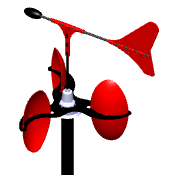All You Need to Find Out About Anemometers: Just How They Function, Why They Matter, and Where to Utilize Them
Anemometers, though usually overlooked in the world of scientific tools, play a critical duty in numerous fields, providing useful insights into wind rate and airflow patterns. Understanding the technicians behind these devices is vital for any individual looking for to harness the power of this data. From meteorologists tracking weather condition patterns to engineers developing structures with wind tons in mind, the applications of anemometers are diverse and significant. As we explore the complexities of anemometer innovation, we will discover the internal workings of these gadgets, their significance, and the crucial factors to consider when selecting the ideal anemometer for particular applications.

Anemometer Fundamentals
A necessary tool used to gauge wind speed and instructions, the anemometer plays a critical function in weather forecasting and different markets. An anemometer usually consists of 3 or 4 mugs that turn in the wind, a vane that points right into the wind, and sensors to track the activities or rotations.
There are numerous kinds of anemometers offered, consisting of cup anemometers, vane anemometers, hot-wire anemometers, and sonic anemometers, each with its one-of-a-kind features and applications. Mug anemometers are commonly utilized for fundamental wind speed measurements, while vane anemometers are favored for directional measurements.
Concepts of Anemometer Operation
Structure on the fundamental understanding of anemometer essentials, the principles of anemometer operation clarify the mechanics behind wind speed and instructions measurements. Anemometers run on the concept of airflow impacting a sensor, causing it to turn. Mug anemometers, as an example, have 3 or even more cups that capture the wind, triggering them to spin much faster as the wind speed increases. The rotation speed is after that exchanged a wind rate dimension. Vane anemometers, on the various other hand, make use of a tail or a probe that straightens itself with the wind instructions, giving a measurement of wind direction based upon the orientation of the sensor. Hot-wire anemometers depend on a warmed cable that cools down as wind passes over it, with the rate of cooling down figuring out the wind speed. Ultrasonic anemometers measure wind rate and direction by assessing the moment it considers ultrasonic signals to travel in between transducers. Recognizing these principles is essential for precise and trusted wind dimensions in different applications.
Value of Anemometers
Anemometers play a vital role in measuring wind speed and instructions, offering crucial information for weather condition projecting, climate studies, environmental tracking, and aeronautics procedures. Meteorologists count on anemometers to collect precise wind data, assisting them comprehend weather condition patterns, anticipate storms, and issue prompt cautions to the public. Wind ranch operators use anemometers to analyze wind problems and maximize electricity production from wind turbines.
Applications Throughout Numerous Industries
In the sustainable energy industry, anemometers play a critical duty in analyzing wind problems for wind ranch positionings, making sure optimal power production. Industries like construction and mining make use of anemometers to monitor wind speeds, essential for safety methods, particularly when functioning at elevations or in open-pit mines where solid winds can pose threats. In agriculture, anemometers assist farmers in taking care of plant splashing by supplying real-time information on wind rate to stay clear of drift.

Picking the Right Anemometer for Your Needs
Selecting the ideal anemometer tailored to your certain demands is vital for obtaining exact wind speed and direction measurements. When selecting an anemometer, think about factors such as the designated application, needed measurement range, ecological problems, and wanted features. For general objectives, a look at here mug anemometer appropriates for determining wind rate, while a vane anemometer gives wind instructions information. Hot-wire anemometers are optimal for reduced airspeed dimensions, and ultrasonic anemometers supply high precision and resilience.

Conclusion
Finally, anemometers play a crucial function in gauging wind rate and direction across different industries. Understanding the concepts of anemometer operation is necessary for choosing the best tool for certain needs. From meteorology to aeronautics, anemometers are important tools for ensuring and gathering accurate data security in various applications. It is necessary to take into consideration the value of anemometers in order to make educated decisions when selecting the most ideal device for gauging wind conditions.
There are different kinds of anemometers readily available, consisting of mug anemometers, vane anemometers, hot-wire anemometers, and sonic anemometers, each with its index unique functions and applications. Mug anemometers are frequently utilized for standard wind speed measurements, while vane anemometers are preferred for directional dimensions. Hot-wire anemometers are ideal for reduced airspeeds, and sonic anemometers are ideal for high-precision dimensions in research and industrial setups.Structure on the foundational understanding of anemometer basics, the concepts of anemometer operation illuminate the mechanics behind wind speed and instructions measurements. For basic functions, a mug anemometer is appropriate for measuring wind speed, while a vane anemometer offers wind instructions data.